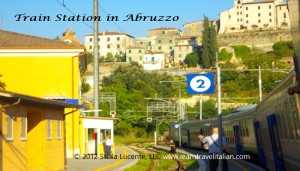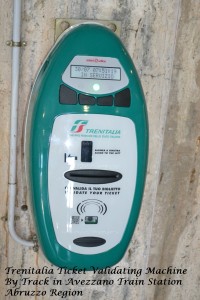Train Travel in Italy for Your Dream Vacation
Follow Caterina in the
Conversational Italian for Travelers series of books!The Conversational Italian for Travelers textbook begins each chapter with a dialogue from a story about the character Caterina, an American girl who travels to Italy to visit her relatives. As the story continues from one chapter to the next, we learn Italian, and about Italy, in an engaging way through Caterina’s experiences.
Train Travel in Italy for Your Dream Vacation
One of the first things Caterina must do after her plane lands in Italy and she passes through customs is find her way on the Italian railway system. To listen to dialogues from Chapters 4 and 5 about Caterina’s encounters as she buys a ticket and boards a train in Italy, go to the interactive dialogues on our website at learntravelitalian.com/interactive.html.
For more images of Train Travel in Italy, visit our Pinterest site Stella Lucente Italian.
The Cultural Note below, also from the textbook, gives a bit of insight into how the Italian railway system works.
—Kathryn Occhipinti

After Caterina arrives in Italy at Malpensa Airport, about 50 km northwest of Milan, she must then make her way into the city. First, she takes a taxi to the nearby town of Gallarate to get onto the local train system, called Trenitalia (www.raileurope.com/Trenitalia-Italy). This local railway cannot be accessed directly from the Malpensa Airport, but until recently, it was the only way to catch a train after flying into Malpensa. The train line from Gallarate goes to the largest terminal in Milan, the Stazione Centrale. Gallarate can also be reached by bus from Malpensa Airport for a small fee, about 1–2 euros, and buses leave regularly from the airport all day. Of course, there are also bus routes to many other nearby cities from the Malpensa bus terminals, including to Milan, for those who prefer to take a bus for the entire trip.
When at the Gallarate train station, Caterina asks for a train that will take her directly to Stazione Centrale, avoiding the possibility of having to change trains along the way. A typical train ticket from Gallarate to Milan should actually cost less than we have noted in the dialogue, and it takes between 40 and 60 minutes to reach Milan.
A newer, separate train system called the Malpensa Express, which opened in 1999, leaves directly from Malpensa’s Terminal 1, underground floor, every 30 minutes. As the name suggests, this train goes directly into Milan, but it ends at a smaller station, the Stazione Cordona. The Malpensa Express trains are new trains with only first-class seats and luggage areas between compartments. Nonstop trains are available in the mornings and late at night, but during the day, there are a few additional stops along the way to Milan for the 40-minute trip. To learn more about the Malpensa Express trains or to view a train schedule and current ticket prices, go to www.malpensaexpress.it.
In our dialogue, the ticket agent Rosa very kindly reminds Caterina to validate her train ticket before boarding the local train. In Italy, when using the local train system, it is possible to buy an “open” ticket, which can be used at any time within a 2-month period. Stamping each ticket with the date and time before entry on the train prevents this type of ticket from being used more than once. The name of the machine that is used to stamp the date and time onto the ticket is translated by the makers of the machine as a “ticket canceling machine” or macchina obliteratrice. The older machines are yellow, but the new machines now in common use have a green and white face with the Trenitalia logo and name along the top.  These small machines are usually found attached to the wall at the entrances of the individual train tracks, which are usually on the lower level of the train station. When referring to what the machine actually does, you can use the verb timbrare, which means to stamp, or convalidare, which means to validate. The verb obliterare, which means to cancel, also means to stamp or to punch when referring to tickets. In effect, all three verbs apply, because the ticket is literally stamped, which validates it for travel, and is canceled for further use at the same time.
These small machines are usually found attached to the wall at the entrances of the individual train tracks, which are usually on the lower level of the train station. When referring to what the machine actually does, you can use the verb timbrare, which means to stamp, or convalidare, which means to validate. The verb obliterare, which means to cancel, also means to stamp or to punch when referring to tickets. In effect, all three verbs apply, because the ticket is literally stamped, which validates it for travel, and is canceled for further use at the same time.
After boarding the train, the ticket inspector (il controllore) will come through each car and ask to see each passenger’s ticket. If the date and time have not been stamped on the ticket, that passenger will be asked to pay a cash fine before leaving the train. Signs are sometimes posted on the interior doors of the trains warning of the fine to be paid if the ticket has not been convalidato (validated)—in Italian, with no English translation! Tickets for the Malpensa Express also need to be validated. So remember to look for those little yellow or green and white machines each time you board a train in Italy and stamp your ticket the way Caterina did. It takes only a second but can save a good deal of money!
A word about the other major airports in Italy: Alitalia flights into Milan used to land primarily at Linate Airport, but nowadays, most passenger airlines land in Malpensa, which is the second largest international airport in Italy.
Rome’s Leonardo da Vinci Airport remains the largest international airport in Italy. It is located 26 km west of Rome, and the nearest city is Fiumicino (which is the old name the airport used to go by and is still used for the airport code: FCO). It is very simple to take the train from this airport to downtown Rome. Just follow the signs to the ticket counter, or buy a ticket at the on-site Alitalia office or from an automatic ticket machine. After a 30-minute ride, the train ends at Roma Termini, which is Rome’s central station.
The Marco Polo Airport serves the city of Venice and is on the mainland, near the town of Mestre, just across the lagoon. The major island of Venice (Venezia) is connected by a bridge to the mainland and is served by a local train station and a large bus station. A city bus or taxi can be taken over this bridge directly into Venice from the airport. A taxi ride to the nearby town of Mestre to the train station is possible and will connect you to points north of Venice on the mainland and to the train station in Venice, the Santa Lucia.
—Adapted from Conversational Italian for Travelers, Chapter 3, “Cultural Note,” © 2012 by Stella Lucente, LLC, by Kathryn Occhipinti

Available on amazon.com and Learn Travel Italian.com
Kathryn Occhipinti, MD, is the author of the
Conversational Italian for Travelers series of books and a teacher of Italian for travelers to Italy in the Peoria and Chicago area.
“Everything you need to know to enjoy your visit to Italy!”
Join my Conversational Italian! Facebook group and follow me on Twitter at StellaLucente@travelitalian1 and start to learn Italian today for FREE!
Conversational Italian! Facebook Group
Tweet @travelitalian1 for Stella Lucente Italian
YouTube videos to learn Italian are available from © Stella Lucente, LLC.
Learn Conversational Italian.
More information on and photographs of Italy can be found on Facebook Stella Lucente Italian and Pinterest Stella Lucente Italian.
Facebook Stella Lucente Italian
Pinterest Stella Lucente Italian
Visit learntravelitalian.com/download.html to purchase/download Conversational Italian for Travelers and find more interesting facts and helpful hints about getting around Italy! Learn how to buy train tickets online, how to make international and local telephone calls, and how to decipher Italian coffee names and restaurant menus, all while gaining the basic understanding of Italian that you will need to know to communicate easily and effectively while in Italy. —From the staff at Stella Lucente, LLC
Train Travel in Italy for Your Dream Vacation

I believe this website got a bit of truly useful stuff on it!
Hello. I found your blog and this is an extremely well
written post. I’ll bookmark it and come back to
read more of your useful info. Thank you for the post.
I’ll surely return.
I am glad you liked my post! I will be posting articles with helpful travel tips about once a month on this blog.
You are offering an essential information. I’ll be your
regular visitor.
I have been reading out lots of your articles and i can claim pretty nice stuff.
I will ensure to bookmark your blog.
I am uncertain where you’re obtaining
your information, nevertheless great topic. I need to spend some time learning or understanding more.
Thank you for great information. I was looking for this info.
Excellent entry! I found it very worthwhile. I’ll check back later to see if more posts
are added.
My only tip would be to write about what ever topic you really love and know well. And above all, have fun with it!
I have been putting quite a bit of time and effort into these blogs, especially if you include trips to Italy so I can gain experience! If you like the blog posts under the Cultural Notes, they are also found in my textbook to learn Italian, Conversational Italian for Travelers, which has helpful hints for travelers in each chapter.
This is a topic that’s close to my heart… Cheers! Exactly where are
your contact details though?
You can contact me through http://www.learntravelitalian.com. Also buy the Conversational Italian books at this site or on amazon.com
Thank you so much! I try to be helpful with travel tips I’ve picked up during my visits to Italy. Also, I am learning more about the Italian language every day so I am hoping what I need to learn will help others if they are trying to learn, too.
Thank you! I do spend a great deal of time on each post. Also, the “cultural notes” are from my books Conversational Italian for Travelers on amazon at http://amzn.to/1TPAo1I so it takes a little less time for these posts!